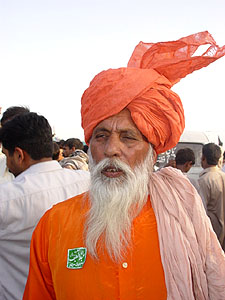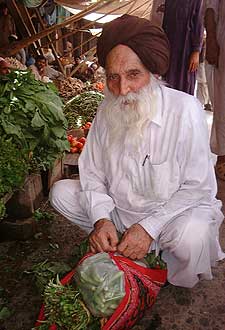Service & Area
Quick Links
Besakhi Festival
 Baisakhi is the day on which the Sikh Nation, the Khalsa (The Pure Ones) was born and Sikhs were given a clear identity and a code of conduct to live by. The event was led by the last living Guru, Guru Gobind Singh Ji, who baptised the first Sikhs using sweet nectar called Amrit. Around the world at Baisakhi time, Sikhs reflect on the values taught to them by their Gurus and celebrate the birth of the Khalsa.
Baisakhi is the day on which the Sikh Nation, the Khalsa (The Pure Ones) was born and Sikhs were given a clear identity and a code of conduct to live by. The event was led by the last living Guru, Guru Gobind Singh Ji, who baptised the first Sikhs using sweet nectar called Amrit. Around the world at Baisakhi time, Sikhs reflect on the values taught to them by their Gurus and celebrate the birth of the Khalsa.
In the second week ( 12 to 14 April ) the Baisakhi Festival is held by the Sikh Community at the Panja Sahib Gurudawara in Hasanabdal near Taxila. About 10,000 Sikhs yatris arrive from all over the world to celeberate the festival.
According to tenets of the religion, Besakhi can only be celebrated in the city of Hasanabdal, where Gurdwara Purnja Sahib is located .In 1921, it was decided by the elders of the Sikh religion to celebrate 'Besakhi' on the first day of Sanskrit month of Besakh, in memory of the day of the first Besakh in the year 1699, when the 10th Guru of the Sikh religion initiating the first five people into the Khalsa
Legend goes, Guru Gobind Singh, had organised for followers from all over India to meet him at the Basakhi Fair in Anandpur in 1699.
 At the gathering when Guru Gobind Singh emerged from a tent with a sword, he asked for volunteers to offer their life for his faith. A young Sikh volunteered, followed the Guru into a tent. Shortly after, the Guru reappeared alone with his sword covered in blood, and asked for a second volunteer. Another Sikh stepped forward and again the Guru took him into the tent, and re-appeared alone, his sword covered in more blood. This was repeated for a third, fourth and fifth volunteer. The crowd became very unnerved, as many believed that the Guru had killed the five Sikhs. He soon came out of the tent again, this time followed by all five Sikhs who were alive and well and dressed in turbans and other symbols that have since become symbols of Sikh identity. He called the five Sikhs the Panj Pyare - the beloved five.
At the gathering when Guru Gobind Singh emerged from a tent with a sword, he asked for volunteers to offer their life for his faith. A young Sikh volunteered, followed the Guru into a tent. Shortly after, the Guru reappeared alone with his sword covered in blood, and asked for a second volunteer. Another Sikh stepped forward and again the Guru took him into the tent, and re-appeared alone, his sword covered in more blood. This was repeated for a third, fourth and fifth volunteer. The crowd became very unnerved, as many believed that the Guru had killed the five Sikhs. He soon came out of the tent again, this time followed by all five Sikhs who were alive and well and dressed in turbans and other symbols that have since become symbols of Sikh identity. He called the five Sikhs the Panj Pyare - the beloved five.
Then the Guru put water in a bowl for sprinkling over the five in a simple initiation ceremony. He said prayers as he stirred the water with a short steel sword , symbolising the need for strength. The Guru's wife, Mata Sundri, then came forward and placed some sugar crystals into the holy water or amrit as a reminder that strength must always be balanced by sweetness of temperament. After completing his prayers, the Guru then sprinkled the amrit over the five.
He declared them to be the first members of a new community of equals, to be called the Khalsa, meaning "pure". These "saint soldiers" were to dedicate their lives to the service of others and the pursuit of justice for people of all faiths. The Panj Pyare were asked to wear five distinctive symbols of their new identity, The five Ks
In a move to end social divisions the five dropped their surnames - traditionally associated with one's caste - and took the common name Singh, meaning "lion", a reminder of the need for courage. At the same time, the Guru gave Sikh women the name or title Kaur, meaning "princess", to emphasise dignity and complete equality.
The Guru then knelt before the five and asked them to initiate him. Hence, the Khalsa became a community in which master and disciple were equal.
For Sikhs, this seasonal festival also has great importance as the founding of the (Soldiers of the Timeless One) at Anandpur Sahib, the famous Golden Temple of Amritsar , India. The Akal Khalsa played an important role in resistance against Mughal rule This act of total surrender of one's life to the service of the AKAL(God), the Timeless One, and at the feet of Guru Gobind Singh created the Sikh religion. For many centuries after that, the first male child of many Hindu families in Punjab was ordained as a Sikh.
We organize package tours to all festivals in different regions of Pakistan.
